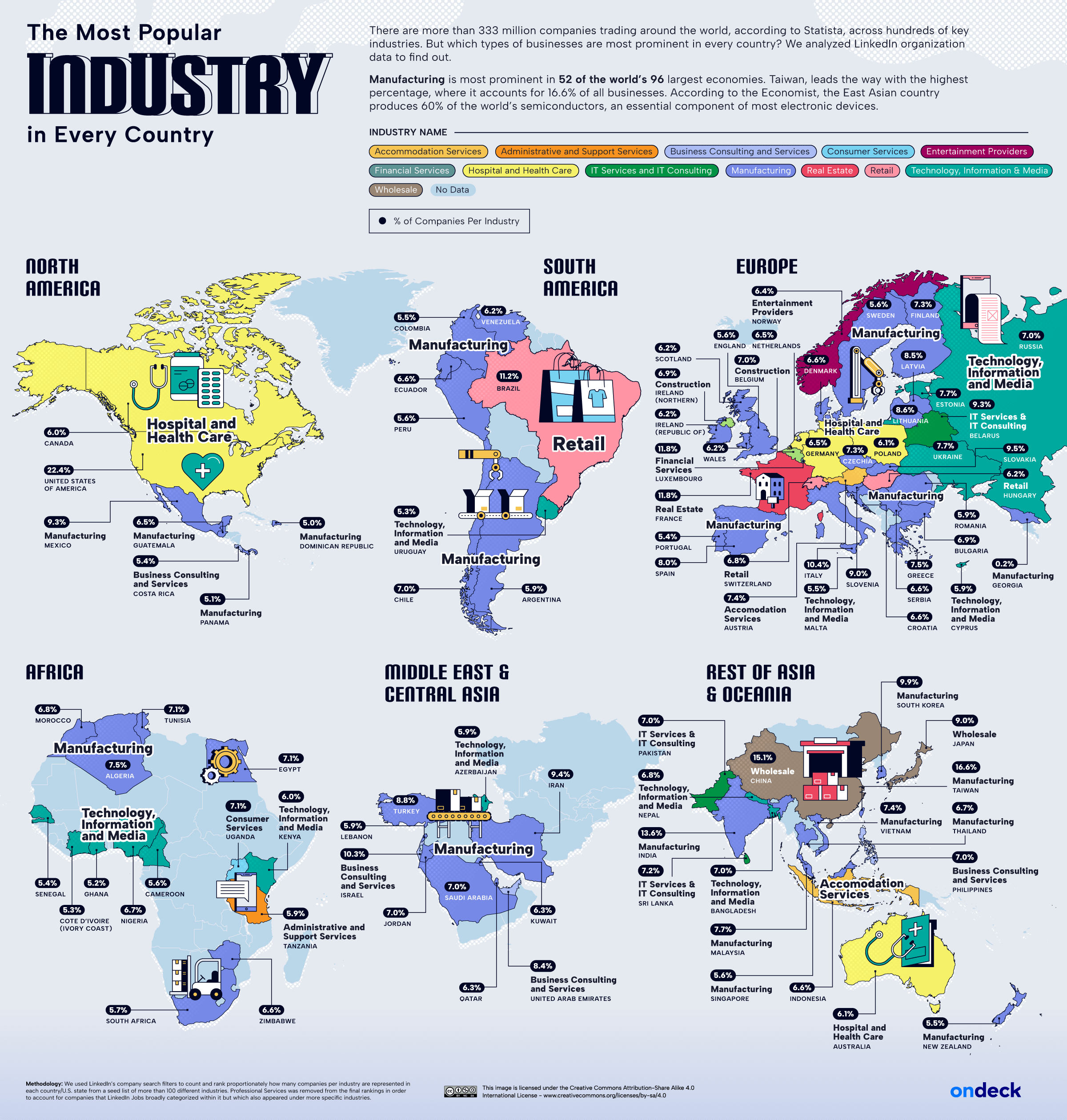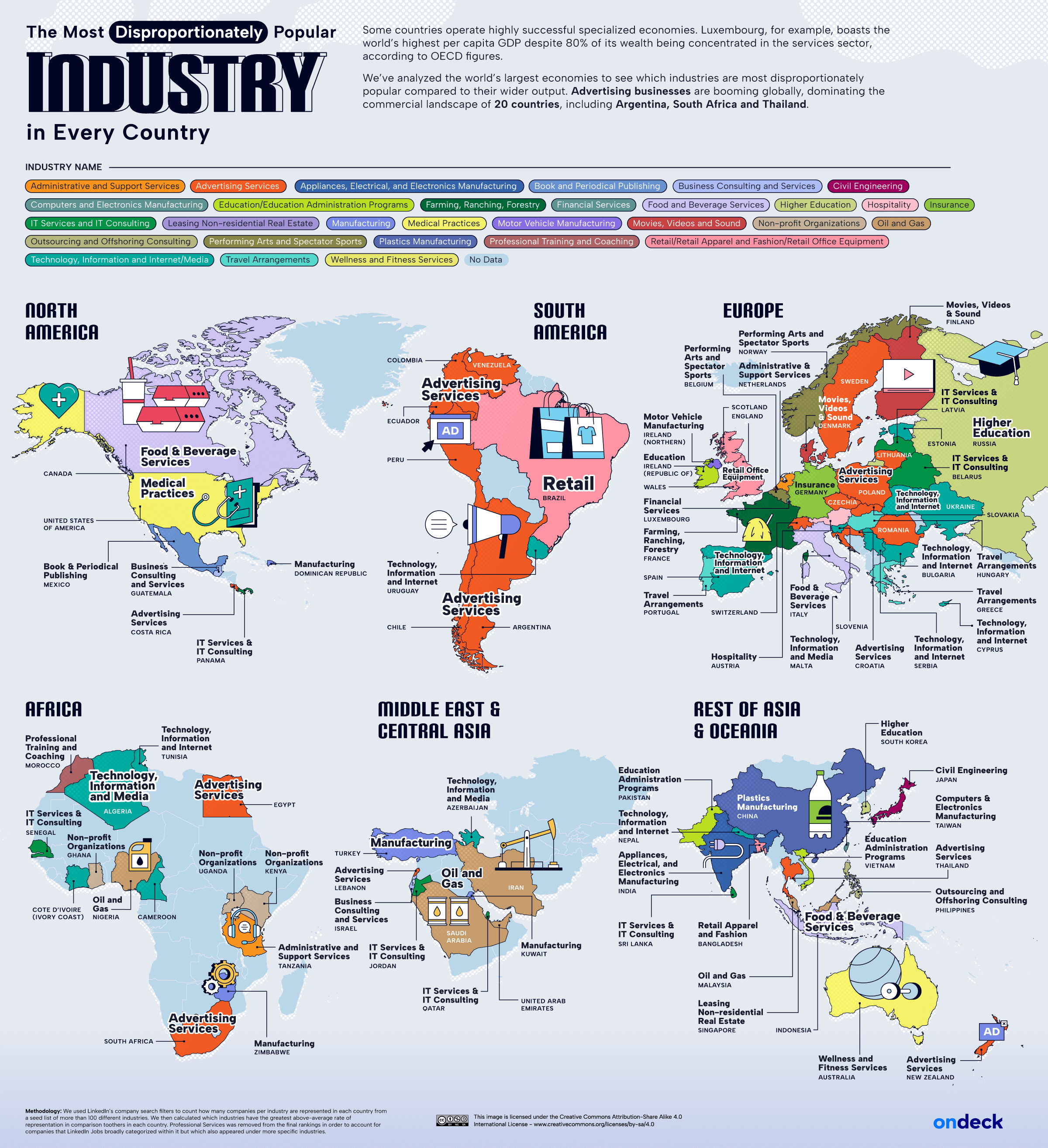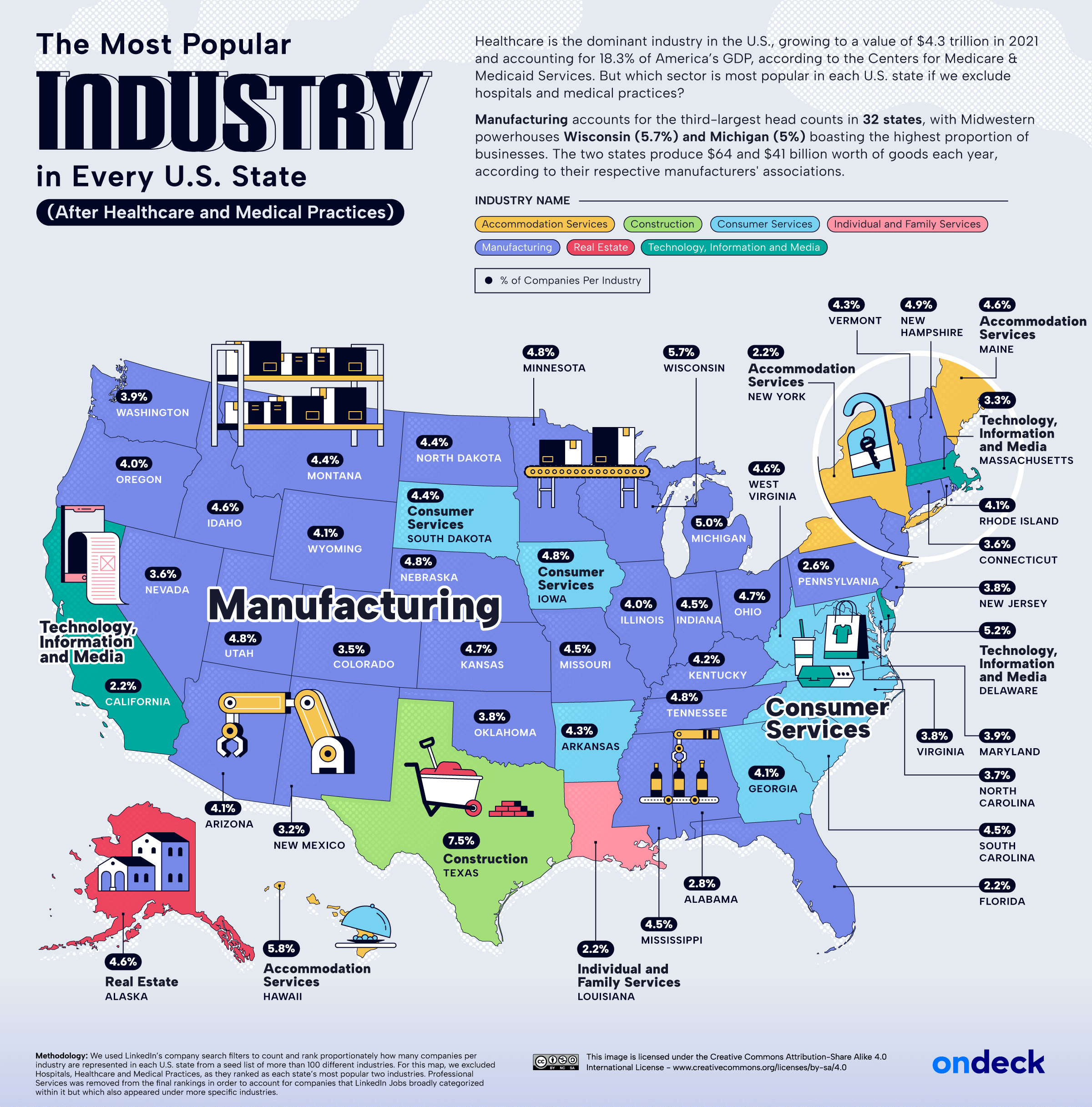The Most Popular Business Industries in Every Country and U.S. State
In today’s globalized world, industry production overwhelmingly dictates the health of our economies. Institutions like the International Monetary Fund (IMF) and the World Bank define a country’s development by its gross domestic product (GDP) and available infrastructure and resources. As of 2023, 57.3% of global GDP is produced by the world’s 41 advanced economies.
More than 250 years ago, the world shifted from agricultural reliance to the rise of industry. Cities like Manchester in the UK set the pace as the world’s first industrial city during the early 19th century, with technological advances inaugurating a period of sustained economic growth in Europe and the U.S., all powered by manufacturing and the global goods trade.
Today, the service economy contributes most significantly to wealth creation, overtaking manufacturing in developed and emerging economies alike. World Trade Organization data shows that it accounted for over half of global GDP in 2019, and UK Government analysis predicts it will rise to 77% by 2035. Not only does it drive the 21st-century global economy, but it also accounts for most people’s livelihoods. According to the Bureau of Labor Statistics, 136 million people in the U.S. alone (approx. 80% of its workforce) are employed in services as of 2021.
If we were to break down these major economic pillars, which industries would appear most popular and which sectors would have the largest headcounts? OnDeck has analyzed more than 82 million businesses in 96 countries to find the most popular industries in every country and U.S. state.
How we Conducted This Study
OnDeck has analyzed LinkedIn data, using its Company Search filters to count and rank proportionately how many companies per industry are represented from a seed list of more than 100 different industries. We also calculated the frequency of an industry’s representation compared to its average number of roles per country or U.S. state.
Key Findings
- Manufacturing is the world’s most popular business industry, with LinkedIn headcounts highest in 52 of 96 economies.
- Advertising is the most disproportionately popular industry, with above-average staff numbers in 20 countries, including Argentina, South Africa and Thailand.
- Manufacturing is America’s third-largest industry (after healthcare and medical practices), with high proportions of roles in 32 states.
- Seven U.S. states have religious institutions as their most disproportionately popular industry, with above-average headcounts in Kentucky, Mississippi, Tennessee and others.
Manufacturing Sector Still Dominates in 52 of 96 Major Economies
Globalization has created a tapestry of international supply chains where industries depend on each other to maintain profitability. While the service industry is valued worldwide and emerging economies continue to rely on professional and technical services for growth, manufacturing is still vitally important. According to McKinsey, it accounts for approximately 16% of the world’s GDP and 14% of its workforce. Naturally, the two go hand in hand. 80% of the world’s global trade, according to the IMF, still consists of manufactured goods and natural materials.

Click here to see the image in full size
Our analysis shows that in 52 major economies, more manufacturing businesses exist than in any other sector. Taiwan has the largest share (16.6% of companies), thanks to a $150 billion semiconductor industry that accounts for 60% of the world’s chip production. Market leader Taiwan Semiconductor Manufacturing Co (TSMC) boasts a market cap of $600 billion, making it Asia’s most valuable company and ninth largest globally.
India also contains a high concentration of manufacturing companies (13.6% of companies). While it currently accounts for 17% of its national GDP, its government’s national manufacturing policy aims to increase this to 25% by 2025. Steel production is a major contributor, and in 2018, India overtook Japan as the world’s second-largest producer of crude steel. It also boasts the world’s fourth-largest car production line, with domestic leader Tata Motors boosting the sector’s global reputation towards a value of $300 billion by 2026.
Advertising on the Rise in Spanish-Speaking South American Countries
Each country has its unique methods of creating wealth, utilizing its natural resources and the skillset among its workforce. The world’s strongest economies produce and export a wide range of goods and services so as not to become reliant on a single industry. According to research from Harvard Growth Labs, Japan has the world’s most complex economy.
However, some countries are much more specialized yet are still able to maintain economic strength. Luxembourg, for example, generates around a third of its GDP (31%) from its financial services sector yet leads the world in GDP per capita, according to the IMF. Our research shows that banks and investment firms are Luxembourg’s most disproportionately popular industry, with an above-average representation of companies compared to the rest of the world.

Click here to see the image in full size
Overall, 20 countries have a disproportionate share of advertising agencies, including six Spanish-speaking countries in South America (Argentina, Chile, Colombia, Ecuador, Peru and Venezuela). An Insider Intelligence report lists Peru, Argentina and Chile as the three fastest-growing digital ad spenders in the world as of 2023. Meanwhile, Argentina’s advertising market grew 116% in 2022, driven by high inflation and Argentina’s FIFA World Cup success.
After Healthcare, Manufacturing Business is Most Popular in 32 U.S. States
The U.S. is renowned for its industrial prowess, exporting everything from refined petroleum to Boeing airliners, but overall, its largest business sector is domestic healthcare. Census Bureau data shows that 14% of America’s total workforce work in the medical profession. In 2021, the Federal Government spent $4.3 trillion (or 18.3% of GDP) on health, twice that of other advanced economies.
If we exclude hospitals, healthcare and medical practices, which are America’s most popular business industries? According to our research, the answer is manufacturing. The sector contributes $2.3 trillion (or 12% of GDP) to the U.S. economy, and our data shows that 32 U.S. states have more companies in this sector than any non-healthcare profession.

Click here to see the image in full size
Leading the industry is Michigan, with 5.7% of its companies in manufacturing. The Great Lake State is home to 17 Fortune 500 companies, with Dow — the world’s third-largest chemical company, as well as automotive giants Ford and General Motors featuring in the top 100. According to the National Association of Manufacturers, businesses in the state employ 587,000 workers — around 14% of its total workforce.
$1.2 Trillion Religious Economy Thrives in Southern U.S. States
Alongside its industrial might, America is also renowned for its faith. A 2021 Gallup poll found that religion is ‘very important’ to 49% of Americans, while three in four identify with a specific denomination. It’s also big business. A report from the Religious Freedom & Business Foundation found that religion adds $1.2 trillion worth of socioeconomic value each year, equivalent to the world’s 15th largest economy.

Click here to see the image in full size
Religious institutions, according to our research, are the most popular disproportionate industry in the U.S., with above-average representation in seven states. Four of these — Mississippi, Tennessee, South Carolina and North Carolina were listed among America’s most religious states in a Pew Research Center poll.
While California is best known globally for its tech exports, real estate is its most disproportionately popular industry. The state is currently seeing record house prices, with the average home fetching for around $791,490 amid state-wide housebuilding shortages and an inflated cost of living. According to the National Association of Realtors, California has the second-most estate agents (behind Florida) in the U.S., with 202,970 working in the sector.
250 Years After Industrial Revolution, Manufacturing Still Key to Unlock Global Growth
The world of work has evolved immeasurably since the days of the Industrial Revolution. In the 19th century, workers toiled away at dangerous machinery for more than ten hours per day, with breaks few and far between. In the U.S., successive presidential administrations introduced regulations in the early 20th century to improve the lives of workers and eradicate draconian practices like child labor.
Today, America and much of the world’s advanced economies benefit from a diverse workforce where skilled workers and high-tech jobs drive innovation and growth. To learn more, you can review our full dataset below, allowing you to see the most popular and unique industry sectors in every country and U.S. state.
While manufacturing is most popular overall, China still dominates the sector, accounting for 28% of global output. However, the industry is evolving rapidly, and Taiwan has been able to secure geopolitical leverage with its dominance of the semiconductor industry.
As the world moves forward, new technological innovations will shape this industry. Artificial intelligence, for example, has enormous untapped potential to revolutionize advanced manufacturing. Nations and industries that stay ahead of the curve can set the tone for the future of the workforce in the years to come.
The Method Behind the Study
To discover the most popular business industries in every country and U.S. state, we analyzed LinkedIn data, using its Company Search filters to count and rank proportionately how many companies per industry are represented from a seed list of more than 100 different industries.
To find each location’s most disproportionately popular industry, we measured how often an industry is represented in comparison to its average representation per country or per U.S. state and selected that country or state’s industry with the greatest above-average rate of representation.
Our final analysis removes Professional Services from being considered in order to account for companies that were broadly bucketed within it but which also appeared under more specific industries.
The data of this analysis is correct as of May 2023.
DISCLAIMER: This content is for informational purposes only. OnDeck and its affiliates do not provide financial, legal, tax or accounting advice.



